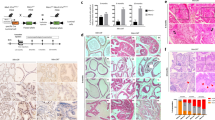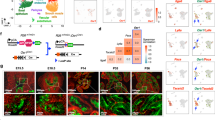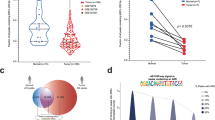Abstract
Emerging evidence has demonstrated the critical roles for both androgen and Wnt pathways in prostate tumorigenesis. A recent integrative genomic analysis of human prostate cancers (PCas) has revealed a unique enrichment of androgen and Wnt signaling in early-onset PCas, implying their clinical significance in the disease. Additionally, interaction between the androgen receptor (AR) and β-catenin has long been detected in PCa cells. However, the consequence of this interaction in prostate tumorigenesis is still unknown. Because mutations in adenomatous polyposis coli, β-catenin and other components of the destruction complex are generally rare in PCas, other mechanisms of aberrant Wnt signaling activation have been speculated. To address these critical questions, we developed Ctnnb1L(ex3)/+/R26hARL/+:PB-Cre4 mice, in which transgenic AR and stabilized β-catenin are co-expressed in prostatic epithelial cells. We observed accelerated tumor development, aggressive tumor invasion and a decreased survival rate in Ctnnb1L(ex3)/+/R26hARL/+:PB-Cre4 compound mice compared with age-matched Ctnnb1L(ex3)/+:PB-Cre4 littermate controls, which only have stabilized β-catenin expression in the prostate. Castration of the above transgenic mice resulted in significant tumor regression, implying an essential role of androgen signaling in tumor growth and maintenance. Implantation of the prostatic epithelial cells isolated from the transgenic mice regenerated prostate intraepithelial neoplasias and prostatic adenocarcinoma lesions. Microarray analyses of transcriptional profiles showed more robust enrichment of known tumor- and metastasis-promoting genes: Spp1, Egr1, c-Myc, Sp5, and Sp6 genes, in samples isolated from Ctnnb1L(ex3)/+/R26hARL/+:PB-Cre4 compound mice than those from Ctnnb1L(ex3)/+:PB-Cre4 and R26hARL/+:PB-Cre4 littermate controls. Together, these data demonstrate a confounding role of androgen signaling in β-catenin-initiated oncogenic transformation in prostate tumorigenesis.
This is a preview of subscription content, access via your institution
Access options
Subscribe to this journal
Receive 50 print issues and online access
$259.00 per year
only $5.18 per issue
Buy this article
- Purchase on SpringerLink
- Instant access to full article PDF
Prices may be subject to local taxes which are calculated during checkout







Similar content being viewed by others
References
Balk SP . Androgen receptor as a target in androgen-independent prostate cancer. Urology 2002; 60: 132–138; discussion 138–139.
Gelmann EP . Molecular biology of the androgen receptor. J Clin Oncol 2002; 20: 3001–3015.
Kyprianou N, Isaacs JT . Activation of programmed cell death in the rat ventral prostate after castration. Endocrinology 1988; 122: 552–562.
Huggins C, Hodges CV . Studies on prostatic cancer: I. The effect of castration, of estrogen and of androgen injection on serum phosphatases in metastatic carcinoma of the prostate. 1941. J Urol 2002; 168: 9–12.
Heinlein CA, Chang C . Androgen receptor in prostate cancer. Endocr Rev 2004; 25: 276–308.
Koivisto P, Kononen J, Palmberg C, Tammela T, Hyytinen E, Isola J et al. Androgen receptor gene amplification: a possible molecular mechanism for androgen deprivation therapy failure in prostate cancer. Cancer Res 1997; 57: 314–319.
Chen CD, Welsbie DS, Tran C, Baek SH, Chen R, Vessella R et al. Molecular determinants of resistance to antiandrogen therapy. Nat Med 2004; 10: 33–39.
Baca SC, Prandi D, Lawrence MS, Mosquera JM, Romanel A, Drier Y et al. Punctuated evolution of prostate cancer genomes. Cell 2013; 153: 666–677.
Verras M, Sun Z . Roles and regulation of Wnt signaling and beta-catenin in prostate cancer. Cancer Lett 2006; 237: 22–32.
Sun Y, Campisi J, Higano C, Beer TM, Porter P, Coleman I et al. Treatment-induced damage to the tumor microenvironment promotes prostate cancer therapy resistance through WNT16B. Nat Med 2012; 18: 1359–1368.
Wissmann C, Wild PJ, Kaiser S, Roepcke S, Stoehr R, Woenckhaus M et al. WIF1, a component of the Wnt pathway, is down-regulated in prostate, breast, lung, and bladder cancer. J Pathol 2003; 201: 204–212.
Nusse R . Wnt signaling in disease and in development. Cell Res 2005; 15: 28–32.
Amit S, Hatzubai A, Birman Y, Andersen JS, Ben-Shushan E, Mann M et al. Axin-mediated CKI phosphorylation of beta-catenin at Ser 45: a molecular switch for the Wnt pathway. Genes Dev 2002; 16: 1066–1076.
Hart MJ, de los Santos R, Albert IN, Rubinfeld B, Polakis P . Downregulation of beta-catenin by human Axin and its association with the APC tumor suppressor, beta-catenin and GSK3 beta. Curr Biol 1998; 8: 573–581.
Latres E, Chiaur DS, Pagano M . The human F box protein beta-Trcp associates with the Cul1/Skp1 complex and regulates the stability of beta-catenin. Oncogene 1999; 18: 849–854.
Aberle H, Bauer A, Stappert J, Kispert A, Kemler R . beta-catenin is a target for the ubiquitin-proteasome pathway. EMBO J 1997; 16: 3797–3804.
Chesire DR, Ewing CM, Gage WR, Isaacs WB . In vitro evidence for complex modes of nuclear beta-catenin signaling during prostate growth and tumorigenesis. Oncogene 2002; 21: 2679–2694.
Gounari F, Signoretti S, Bronson R, Klein L, Sellers WR, Kum J et al. Stabilization of beta-catenin induces lesions reminiscent of prostatic intraepithelial neoplasia, but terminal squamous transdifferentiation of other secretory epithelia. Oncogene 2002; 21: 4099–4107.
Bierie B, Nozawa M, Renou JP, Shillingford JM, Morgan F, Oka T et al. Activation of beta-catenin in prostate epithelium induces hyperplasias and squamous transdifferentiation. Oncogene 2003; 22: 3875–3887.
Pearson HB, Phesse TJ, Clarke AR . K-ras and Wnt signaling synergize to accelerate prostate tumorigenesis in the mouse. Cancer Res 2009; 69: 94–101.
Bruxvoort KJ, Charbonneau HM, Giambernardi TA, Goolsby JC, Qian CN, Zylstra CR et al. Inactivation of Apc in the mouse prostate causes prostate carcinoma. Cancer Res 2007; 67: 2490–2496.
Chesire DR, Ewing CM, Sauvageot J, Bova GS, Isaacs WB . Detection and analysis of beta-catenin mutations in prostate cancer. Prostate 2000; 45: 323–334.
Gerstein AV, Almeida TA, Zhao G, Chess E, Shih Ie M, Buhler K et al. APC/CTNNB1 (beta-catenin) pathway alterations in human prostate cancers. Genes Chromosomes Cancer 2002; 34: 9–16.
Henrique R, Ribeiro FR, Fonseca D, Hoque MO, Carvalho AL, Costa VL et al. High promoter methylation levels of APC predict poor prognosis in sextant biopsies from prostate cancer patients. Clin Cancer Res 2007; 13: 6122–6129.
Chen Y, Li J, Yu X, Li S, Zhang X, Mo Z et al. APC gene hypermethylation and prostate cancer: a systematic review and meta-analysis. Eur J Hum Genet 2013; 21: 929–935.
Mulholland DJ, Cheng H, Reid K, Rennie PS, Nelson CC . The androgen receptor can promote beta-catenin nuclear translocation independently of adenomatous polyposis coli. J Biol Chem 2002; 277: 17933–17943.
Truica CI, Byers S, Gelmann EP . Beta-catenin affects androgen receptor transcriptional activity and ligand specificity. Cancer Res 2000; 60: 4709–4713.
Yang F, Li X, Sharma M, Sasaki CY, Longo DL, Lim B et al. Linking beta-catenin to androgen-signaling pathway. J Biol Chem 2002; 277: 11336–11344.
Weischenfeldt J, Simon R, Feuerbach L, Schlangen K, Weichenhan D, Minner S et al. Integrative genomic analyses reveal an androgen-driven somatic alteration landscape in early-onset prostate cancer. Cancer Cell 2013; 23: 159–170.
Stanbrough M, Leav I, Kwan PW, Bubley GJ, Balk SP . Prostatic intraepithelial neoplasia in mice expressing an androgen receptor transgene in prostate epithelium. Proc Natl Acad Sci USA 2001; 98: 10823–10828.
Zhu C, Luong R, Zhuo M, Johnson DT, McKenney JK, Cunha GR et al. Conditional expression of the androgen receptor induces oncogenic transformation of the mouse prostate. J Biol Chem 2011; 286: 33478–33488.
Ittmann M, Huang J, Radaelli E, Martin P, Signoretti S, Sullivan R et al. Animal models of human prostate cancer: the consensus report of the New York meeting of the Mouse Models of Human Cancers Consortium Prostate Pathology Committee. Cancer Res 2013; 73: 2718–2736.
Muzumdar MD, Tasic B, Miyamichi K, Li L, Luo L . A global double-fluorescent Cre reporter mouse. Genesis 2007; 45: 593–605.
Ding Z, Wu CJ, Chu GC, Xiao Y, Ho D, Zhang J et al. SMAD4-dependent barrier constrains prostate cancer growth and metastatic progression. Nature 2011; 470: 269–273.
Sauer L, Gitenay D, Vo C, Baron VT . Mutant p53 initiates a feedback loop that involves Egr-1/EGF receptor/ERK in prostate cancer cells. Oncogene 2010; 29: 2628–2637.
Ellwood-Yen K, Graeber TG, Wongvipat J, Iruela-Arispe ML, Zhang J, Matusik R et al. Myc-driven murine prostate cancer shares molecular features with human prostate tumors. Cancer Cell 2003; 4: 223–238.
Mahmoudi T, Boj SF, Hatzis P, Li VS, Taouatas N, Vries RG et al. The leukemia-associated Mllt10/Af10-Dot1l are Tcf4/beta-catenin coactivators essential for intestinal homeostasis. PLoS Biol 2010; 8: e1000539.
Chesire DR, Isaacs WB . Beta-catenin signaling in prostate cancer: an early perspective. Endocr Relat Cancer 2003; 10: 537–560.
Heinlein CA, Chang C . Androgen receptor (AR) coregulators: an overview. Endocr Rev 2002; 23: 175–200.
Wang Y, Revelo MP, Sudilovsky D, Cao M, Chen WG, Goetz L et al. Development and characterization of efficient xenograft models for benign and malignant human prostate tissue. Prostate 2005; 64: 149–159.
de Ronde JJ, Lips EH, Mulder L, Vincent AD, Wesseling J, Nieuwland M et al. SERPINA6, BEX1, AGTR1, SLC26A3, and LAPTM4B are markers of resistance to neoadjuvant chemotherapy in HER2-negative breast cancer. Breast Cancer Res Treat 2013; 137: 213–223.
Ibarretxe G, Aurrekoetxea M, Crende O, Badiola I, Jimenez-Rojo L, Nakamura T et al. Epiprofin/Sp6 regulates Wnt-BMP signaling and the establishment of cellular junctions during the bell stage of tooth development. Cell Tissue Res 2012; 350: 95–107.
Matusik RJ, Jin RJ, Sun Q, Wang Y, Yu X, Gupta A et al. Prostate epithelial cell fate. Differentiation 2008; 76: 682–698.
Wang X, Kruithof-de Julio M, Economides KD, Walker D, Yu H, Halili MV et al. A luminal epithelial stem cell that is a cell of origin for prostate cancer. Nature 2009; 461: 495–500.
Harada N, Tamai Y, Ishikawa T, Sauer B, Takaku K, Oshima M et al. Intestinal polyposis in mice with a dominant stable mutation of the beta-catenin gene. Embo J 1999; 18: 5931–5942.
Wu X, Wu J, Huang J, Powell WC, Zhang J, Matusik RJ et al. Generation of a prostate epithelial cell-specific Cre transgenic mouse model for tissue-specific gene ablation. Mech Dev 2001; 101: 61–69.
Johnson DT, Luong R, Lee SH, Peng Y, Shaltouki A, Lee JT et al. Deletion of leucine zipper tumor suppressor 2 (lzts2) increases susceptibility to tumor development. J Biol Chem 2013; 288: 3727–3738.
Kwak MK, Johnson DT, Zhu C, Lee SH, Ye DW, Luong R et al. Conditional deletion of the Pten gene in the mouse prostate induces prostatic intraepithelial neoplasms at early ages but a slow progression to prostate tumors. PLoS One 2013; 8: e53476.
Sugimura Y, Cunha GR, Donjacour AA . Morphological and histological study of castration-induced degeneration and androgen-induced regeneration in the mouse prostate. Biol Reprod 1986; 34: 973–983.
Xin L, Ide H, Kim Y, Dubey P, Witte ON . In vivo regeneration of murine prostate from dissociated cell populations of postnatal epithelia and urogenital sinus mesenchyme. Proc Natl Acad Sci USA 2003; 100: 11896–11903.
Hohaus S, Petrovick MS, Voso MT, Sun Z, Zhang DE . Tenen DG. PU.1 (Spi-1) and C/EBP alpha regulate expression of the granulocyte- macrophage colony-stimulating factor receptor alpha gene. Mol Cell Biol 1995; 15: 5830–5845.
Livak KJ, Schmittgen TD . Analysis of relative gene expression data using real-time quantitative PCR and the 2(-Delta Delta C(T)) Method. Methods 2001; 25: 402–408.
Lee J, Beliakoff J, Sun Z . The novel PIAS-like protein hZimp10 is a transcriptional co-activator of the p53 tumor suppressor. Nucleic Acids Res 2007; 35: 4523–4534.
Acknowledgements
We thank Dr William Tu and Dr Chunfang Zhu for their technical assistance. This work was supported by the NIH grants R01-CA070297, R01-CA151623, U01-CA166894 and R21-CA190021.
Author information
Authors and Affiliations
Corresponding author
Ethics declarations
Competing interests
The authors declare no conflict interest.
Additional information
Supplementary Information accompanies this paper on the Oncogene website
Rights and permissions
About this article
Cite this article
Lee, S., Luong, R., Johnson, D. et al. Androgen signaling is a confounding factor for β-catenin-mediated prostate tumorigenesis. Oncogene 35, 702–714 (2016). https://doi.org/10.1038/onc.2015.117
Received:
Revised:
Accepted:
Published:
Issue date:
DOI: https://doi.org/10.1038/onc.2015.117
This article is cited by
-
Pretreatment of prostate cancer cells with salinomycin and Wnt inhibitor increases the efficacy of cabazitaxel by inducing apoptosis and decreasing cancer stem cells
Medical Oncology (2023)
-
Novel prostate cancer susceptibility gene SP6 predisposes patients to aggressive disease
Prostate Cancer and Prostatic Diseases (2021)
-
Androgen receptor with short polyglutamine tract preferably enhances Wnt/β-catenin-mediated prostatic tumorigenesis
Oncogene (2020)
-
Androgen signaling is essential for development of prostate cancer initiated from prostatic basal cells
Oncogene (2019)
-
Loss of the tumor suppressor, Tp53, enhances the androgen receptor-mediated oncogenic transformation and tumor development in the mouse prostate
Oncogene (2019)



